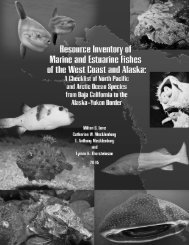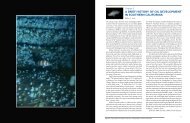Reproductive Ecology and Body Burden of Resident ... - The Love Lab
Reproductive Ecology and Body Burden of Resident ... - The Love Lab
Reproductive Ecology and Body Burden of Resident ... - The Love Lab
You also want an ePaper? Increase the reach of your titles
YUMPU automatically turns print PDFs into web optimized ePapers that Google loves.
Channel region. Miller <strong>and</strong> Shanks (2004) found that Mg concentrations, <strong>and</strong> Zn <strong>and</strong> Pb concentrations<br />
to a lesser extent, in otoliths <strong>of</strong> black rockfish (Sebastes melanops) were good discriminators <strong>of</strong> open coast<br />
habitats along the Washington <strong>and</strong> Oregon coasts. Nishimoto (2009) examined the variability in otolith<br />
chemistry in relation to temperature <strong>and</strong> salinity <strong>and</strong> determined that Ba, Mg, <strong>and</strong> Fe concentrations in<br />
otoliths distinguished shortbelly rockfish (Sebastes jordani) from geographically distant regions with contrasting<br />
oceanographic conditions.<br />
Brown (2006) found that Pacific s<strong>and</strong>dab living in estuaries <strong>and</strong> s<strong>and</strong>y coastal habitats along the central<br />
California coast had different elemental signatures defined by Sr, Li, Ba, <strong>and</strong> Mn. <strong>The</strong> signatures defining<br />
the two habitats for Pacific s<strong>and</strong>dab were similar for English sole (Pleuronectes vetulus), another flatfish species<br />
that resides in the same habitats. Sr was consistently higher <strong>and</strong> Li consistently lower in estuarine fish.<br />
Ba <strong>and</strong> Mn differed between habitats in only some years.<br />
Forrester <strong>and</strong> Swearer (2002) compared Cu, Sr, Ba, <strong>and</strong> Pb concentrations in otoliths <strong>of</strong> California halibut<br />
from bay <strong>and</strong> open coast habitats in the southern California Bight including the Santa Barbara Channel.<br />
In contrast to Brown (2006), Sr <strong>and</strong> Ba showed no significant difference in concentration in juveniles from<br />
bays <strong>and</strong> open coast habitats. Mn, Cu, <strong>and</strong> Pb were higher in otoliths from bays than from coastal habitats<br />
in the single year, 1998, when fish were collected from both kinds <strong>of</strong> habitats. Forrester <strong>and</strong> Swearer (2002)<br />
also compared the otolith element concentrations from one year <strong>of</strong> sampling open coast habitats with four<br />
previous years <strong>of</strong> sampling fish from bays. Mn was ruled out as a good marker, because otolith concentrations<br />
from the open coast habitat in 1998 did not differ from otolith Mn from bays the four previous years.<br />
Although Ba concentrations in otoliths did not differ between bay <strong>and</strong> open coast habitats in 1998; Ba in<br />
otoliths from bay habitats in some years were significantly higher than coastal habitats sampled in 1998.<br />
Otolith concentrations <strong>of</strong> Pb varied less than Cu between years among the bay sites. Findings from these<br />
studies indicate that some elements may be more temporally stable than others in otolith elemental signatures.<br />
Success in discriminating otoliths from the two different habitat types in this study was not associated<br />
with observed seawater element concentrations. Regression analysis showed variability in otolith element<br />
concentration among sites was not related to the concentration <strong>of</strong> the elements in our seawater samples<br />
from kelp rockfish <strong>and</strong> s<strong>and</strong>dab habitats.<br />
<strong>The</strong> variability in seawater sample concentrations <strong>of</strong> most elements within sites (platform or natural<br />
habitat) was substantial (Fig. 8) indicating a source <strong>of</strong> error may have been our seawater collection method.<br />
<strong>The</strong> seawater samples were taken from aboard an unanchored boat at the platforms <strong>and</strong> natural s<strong>and</strong>dab<br />
habitat sites. Although the boat was repositioned between casts to adjust for drift particularly when near<br />
a platform, <strong>and</strong> movement may have been (tens <strong>of</strong> meters at platforms; tens <strong>of</strong> meters to several hundred<br />
meters from natural s<strong>and</strong>dab habitat collection sites). Although care was taken to minimize contamination<br />
<strong>of</strong> the seawater collected from the Niskin bottle sampler, we cannot fully rule out contamination from the<br />
bottle which was not acid-leached. For some trace elements (e.g., Ba, V, As, Se) contamination is relatively<br />
easy to control, whereas for other elements (e.g., Pb, Zn, Fe, Hg, <strong>and</strong> Sn) more painstaking procedures are<br />
required to collect uncontaminated samples (Donat <strong>and</strong> Brul<strong>and</strong> 1995).<br />
Another source <strong>of</strong> error in estimating the relationship between element concentrations in otoliths <strong>and</strong><br />
seawater is that seawater was sampled only during a single visit to each site; whereas, the otolith elemental<br />
concentration was measured from ablated samples integrating months <strong>of</strong> recent growth preceding capture<br />
<strong>of</strong> the fish. We suspect that the element concentrations from the ablated otolith sample is affected by temporal<br />
variability in seawater element concentrations over multiple time scales ranging from hours to months<br />
due to changes in the rate <strong>of</strong> produced water discharge from a platform <strong>and</strong> oceanographic variability.<br />
Produced water is the primary discharge associated with oil <strong>and</strong> gas recovery <strong>and</strong> is the second largest<br />
non-drilling associated discharge from oil platforms. Cooling water discharges comprise the largest volume<br />
60




